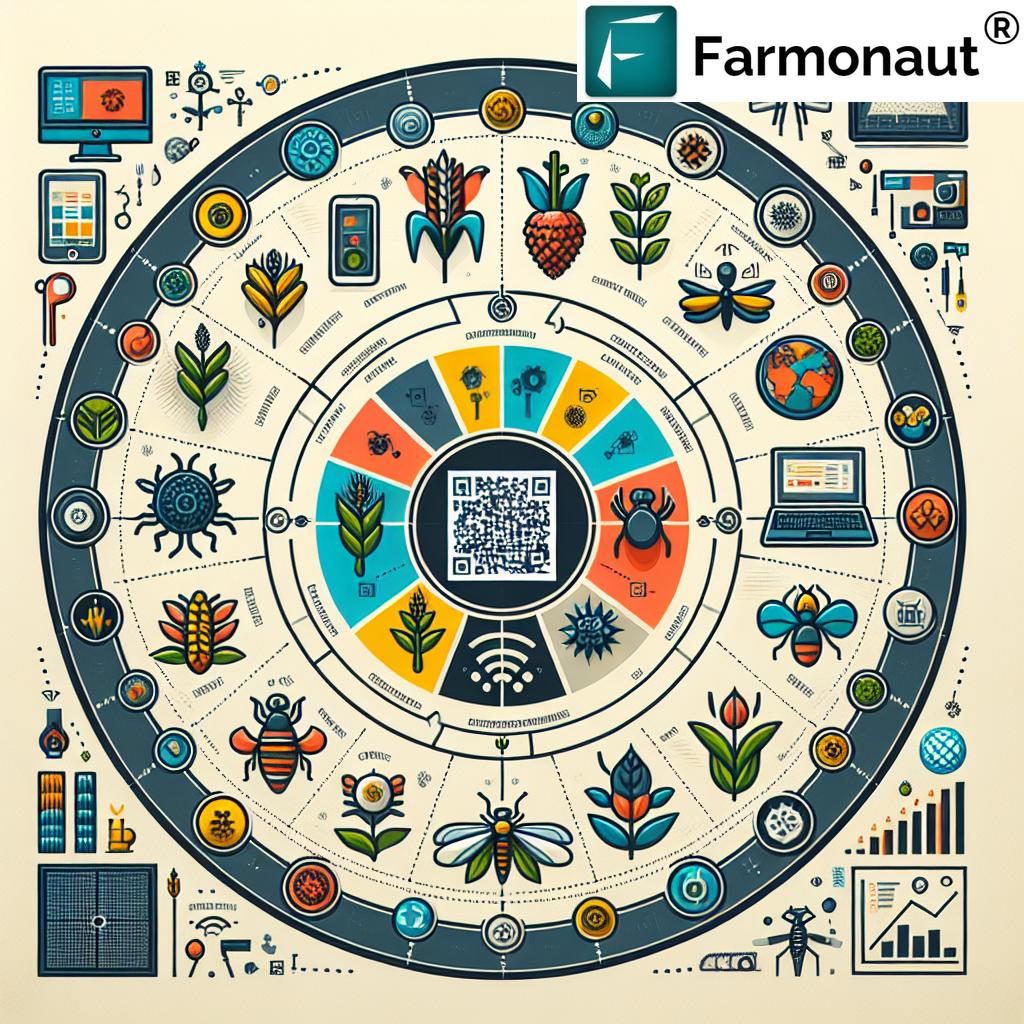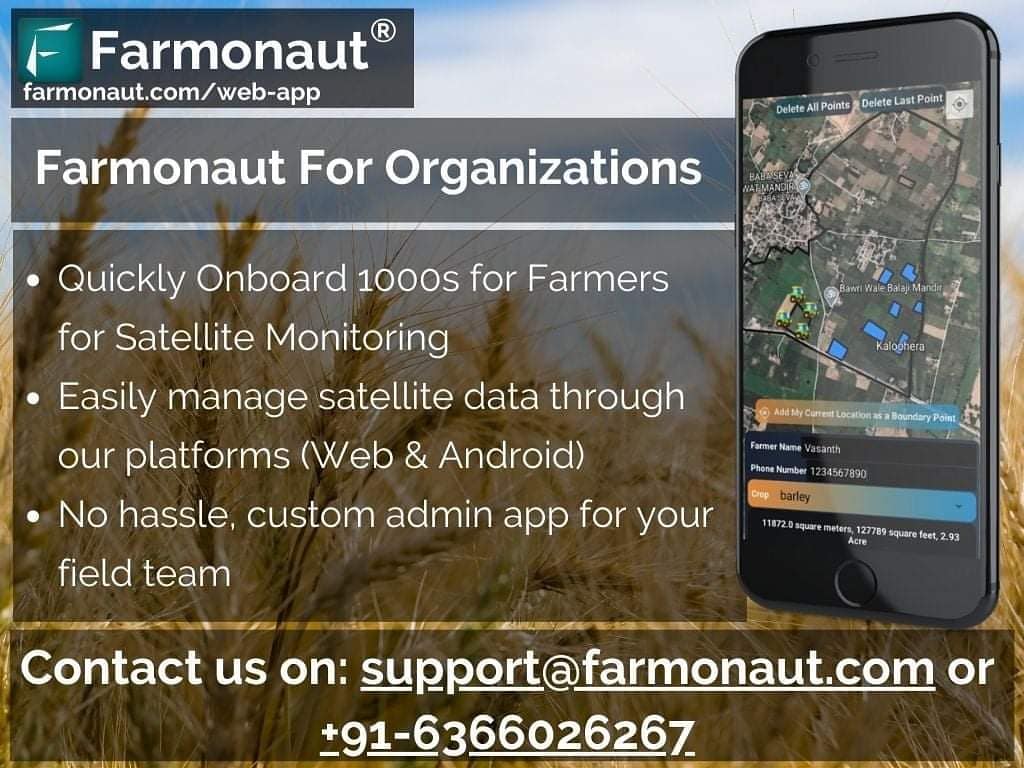
Comprehensive Guide: Identifying and Managing Diseases and Pests in 60+ Crops – From Apples to Zucchini
At Farmonaut, we understand the challenges farmers face in managing crop health and protecting their yields from various diseases and pests. In this comprehensive guide, we’ll explore the most common issues affecting over 60 crops, from apples to zucchini, and provide insights on how to identify and manage these problems effectively. We’ll also discuss how our satellite-based technology can revolutionize pest and disease management in agriculture.
1. Fruit Crops
1.1 Apple
Apples are susceptible to various diseases and pests that can significantly impact yield and fruit quality. Some common issues include:
- Apple Scab: Caused by the fungus Venturia inaequalis, this disease results in dark, scab-like lesions on leaves and fruit.
- Fire Blight: A bacterial disease that causes branches to appear scorched.
- Codling Moth: A major pest that burrows into the fruit, causing significant damage.
Our satellite-based monitoring can detect early signs of stress in apple orchards, allowing for timely interventions.
1.2 Grape
Grapes are prone to several diseases and pests, including:
- Powdery Mildew: A fungal disease that appears as a white, powdery coating on leaves and fruit.
- Botrytis Bunch Rot: Also known as gray mold, this fungal disease affects ripening fruit clusters.
- Phylloxera: An insect pest that attacks grape roots, potentially devastating entire vineyards.
Farmonaut’s technology can help vineyard managers identify areas of stress before visible symptoms appear, enabling targeted treatments.
1.3 Citrus
Citrus fruits face several challenges, including:
- Citrus Canker: A bacterial disease causing lesions on leaves, stems, and fruit.
- Citrus Greening (Huanglongbing): A devastating bacterial disease spread by insects.
- Mediterranean Fruit Fly: A serious pest that can damage a wide range of fruits.
Our satellite imagery can detect changes in tree health, allowing for early identification of potential disease outbreaks.
1.4 Mango
Mango trees are susceptible to various issues, including:
- Anthracnose: A fungal disease causing black spots on leaves and fruit.
- Mango Malformation: A disease that affects flowering and fruit set.
- Mango Seed Weevil: An insect pest that damages the fruit from within.
Farmonaut’s technology can help mango growers monitor orchard health and detect stress patterns across large areas.
1.5 Banana
Banana plantations face several challenges, such as:
- Panama Disease: A fungal disease that causes wilting and plant death.
- Black Sigatoka: A leaf spot disease that can significantly reduce yields.
- Banana Weevil: An insect pest that burrows into the plant’s corm and pseudostem.
Our satellite-based monitoring can help detect early signs of disease spread in banana plantations, enabling targeted interventions.
2. Vegetable Crops
2.1 Tomato
Tomatoes are prone to numerous diseases and pests, including:
- Early Blight: A fungal disease causing circular brown spots on leaves.
- Tomato Yellow Leaf Curl Virus: A viral disease spread by whiteflies.
- Tomato Hornworm: A large caterpillar that can quickly defoliate plants.
Farmonaut’s technology can help tomato growers identify areas of stress and potential disease outbreaks before they become visible to the naked eye.
2.2 Potato
Potatoes face several challenges, such as:
- Late Blight: A devastating fungal disease that caused the Irish Potato Famine.
- Colorado Potato Beetle: An insect pest that can quickly defoliate plants.
- Potato Cyst Nematode: A soil-borne pest that affects root development.
Our satellite-based monitoring can help potato farmers detect early signs of stress and disease spread across large fields.
2.3 Onion
Onions are susceptible to various issues, including:
- Downy Mildew: A fungal disease that causes yellowish-green patches on leaves.
- Onion Thrips: Tiny insects that can cause significant damage to leaves.
- White Rot: A fungal disease that affects the bulb and roots.
Farmonaut’s technology can help onion growers identify areas of stress and potential disease outbreaks across large fields.
2.4 Cabbage
Cabbage crops face several challenges, such as:
- Black Rot: A bacterial disease causing V-shaped lesions on leaves.
- Clubroot: A soil-borne disease that affects root development.
- Cabbage Looper: A caterpillar pest that feeds on leaves.
Our satellite-based monitoring can help cabbage farmers detect early signs of stress and disease spread, enabling targeted interventions.
3. Grain Crops
3.1 Wheat
Wheat is susceptible to various diseases and pests, including:
- Wheat Rust: Fungal diseases like stem rust, leaf rust, and stripe rust.
- Fusarium Head Blight: A fungal disease affecting grain quality.
- Hessian Fly: An insect pest that can cause significant yield losses.
Farmonaut’s technology can help wheat farmers monitor crop health across large fields and detect potential disease outbreaks early.
3.2 Rice
Rice crops face several challenges, such as:
- Rice Blast: A fungal disease affecting leaves, stems, and panicles.
- Bacterial Leaf Blight: A bacterial disease causing leaf discoloration and wilting.
- Brown Planthopper: An insect pest that can cause “hopper burn” and significant yield losses.
Our satellite-based monitoring can help rice growers identify areas of stress and potential disease outbreaks across large paddy fields.
3.3 Maize (Corn)
Maize crops are prone to various issues, including:
- Northern Corn Leaf Blight: A fungal disease causing long, grayish-green lesions on leaves.
- Corn Earworm: An insect pest that feeds on developing kernels.
- Stalk Rot: Various fungal diseases that weaken the plant’s stalk.
Farmonaut’s technology can help maize farmers detect early signs of stress and disease spread across large fields.
4. Legume Crops
4.1 Soybean
Soybeans face several challenges, such as:
- Soybean Rust: A fungal disease that can cause severe defoliation.
- Sudden Death Syndrome: A soil-borne fungal disease affecting roots and leaves.
- Soybean Aphid: An insect pest that can cause significant yield losses.
Our satellite-based monitoring can help soybean growers identify areas of stress and potential disease outbreaks across large fields.
4.2 Peanut
Peanut crops are susceptible to various issues, including:
- Early Leaf Spot: A fungal disease causing circular brown spots on leaves.
- Tomato Spotted Wilt Virus: A viral disease spread by thrips.
- Lesser Cornstalk Borer: An insect pest that can damage pods and plants.
Farmonaut’s technology can help peanut farmers detect early signs of stress and disease spread, enabling targeted interventions.
5. Industrial Crops
5.1 Cotton
Cotton crops face several challenges, such as:
- Cotton Boll Weevil: An insect pest that feeds on cotton squares and bolls.
- Bacterial Blight: A bacterial disease causing angular leaf spots and boll rot.
- Verticillium Wilt: A soil-borne fungal disease affecting plant vascular systems.
Our satellite-based monitoring can help cotton growers identify areas of stress and potential disease outbreaks across large fields.
5.2 Sugarcane
Sugarcane is prone to various diseases and pests, including:
- Red Rot: A fungal disease affecting the stalk internodes.
- Sugarcane Mosaic Virus: A viral disease causing mosaic patterns on leaves.
- Sugarcane Borer: An insect pest that tunnels into stalks.
Farmonaut’s technology can help sugarcane farmers detect early signs of stress and disease spread across large plantations.
6. Specialty Crops
6.1 Coffee
Coffee plants face several challenges, such as:
- Coffee Berry Borer: An insect pest that burrows into coffee berries.
- Coffee Leaf Rust: A fungal disease causing orange lesions on leaves.
- Root-Knot Nematodes: Soil-borne pests that affect root development.
Our satellite-based monitoring can help coffee growers identify areas of stress and potential disease outbreaks across large plantations.
6.2 Tea
Tea plants are susceptible to various issues, including:
- Blister Blight: A fungal disease causing blisters on leaves.
- Tea Mosquito Bug: An insect pest that damages young shoots.
- Red Spider Mite: A pest that causes bronzing of leaves.
Farmonaut’s technology can help tea plantation managers detect early signs of stress and disease spread across large areas.
Farmonaut’s Satellite-Based Approach to Pest and Disease Management
At Farmonaut, we leverage advanced satellite technology to revolutionize how farmers detect and manage pests and diseases across various crops. Our approach offers several advantages over traditional methods:
- Early Detection: Satellite imagery can detect changes in plant health before visible symptoms appear, allowing for proactive management.
- Large-Scale Monitoring: Our technology can efficiently monitor vast areas, making it ideal for large farms and plantations.
- Precision Targeting: By identifying specific areas of concern, farmers can apply treatments more precisely, reducing costs and environmental impact.
- Time and Resource Savings: Satellite monitoring reduces the need for extensive manual field scouting, saving time and labor costs.
Here’s a comparison of traditional methods versus Farmonaut’s satellite-based approach for various crops:
| Crop | Traditional Method | Farmonaut Method | Benefits |
|---|---|---|---|
| Wheat | Manual field scouting, visual inspection | Satellite-based vegetation health monitoring | Early detection of stress, large-scale monitoring |
| Apple | Regular orchard walks, visual inspection | Multispectral imagery analysis | Precise identification of problem areas, early intervention |
| Cotton | Manual pest scouting, sticky traps | AI-driven analysis of satellite imagery | Rapid detection of pest hotspots, targeted treatment |
| Rice | Field sampling, visual inspection | Satellite-based crop health monitoring | Early detection of disease outbreaks, large-scale monitoring |
| Grape | Regular vineyard inspections | Multispectral and thermal imaging | Early detection of water stress and disease, precision management |
How Farmonaut Can Help You Manage Crop Health
Our satellite-based farm management solutions offer powerful tools to help you monitor and manage crop health effectively:
- Real-time Crop Health Monitoring: Our platform provides up-to-date information on vegetation health, helping you identify potential issues early.
- AI-powered Advisory: Our Jeevn AI system analyzes satellite data and provides personalized recommendations for crop management.
- Weather Forecasting: Access accurate weather forecasts to plan your pest and disease management activities effectively.
- Historical Data Analysis: Compare current crop health with historical data to identify trends and potential recurring issues.
To get started with Farmonaut and revolutionize your approach to pest and disease management, visit our website or download our app:
- Web Application: https://farmonaut.com/app_redirect
- Android App: Download from Google Play
- iOS App: Download from App Store
FAQs
Q: How accurate is satellite-based crop health monitoring?
A: Satellite-based monitoring can be highly accurate, detecting changes in crop health with precision. However, it’s always best to combine this technology with on-ground verification for the most comprehensive approach.
Q: Can Farmonaut’s technology detect specific pests or diseases?
A: While our technology can detect changes in crop health that may indicate pest or disease presence, it cannot identify specific pests or pathogens. It’s a powerful tool for early detection and targeted scouting.
Q: How often is the satellite data updated?
A: The frequency of updates depends on the package you choose. We offer options ranging from daily to weekly updates, depending on your needs and budget.
Q: Is Farmonaut’s technology suitable for small farms?
A: Yes, we offer solutions suitable for farms of all sizes. Our goal is to make precision agriculture accessible to all farmers, regardless of the scale of their operations.
Q: How can I integrate Farmonaut’s data into my existing farm management system?
A: We offer API access that allows you to integrate our satellite and weather data into your existing systems. For more information, visit our API documentation.
Subscribe to Farmonaut
Ready to transform your approach to crop health management? Subscribe to Farmonaut today and gain access to our powerful satellite-based monitoring tools:
By leveraging Farmonaut’s advanced technology, you can stay ahead of pest and disease issues, optimize your resource use, and maximize your crop yields. Join the precision agriculture revolution today!













